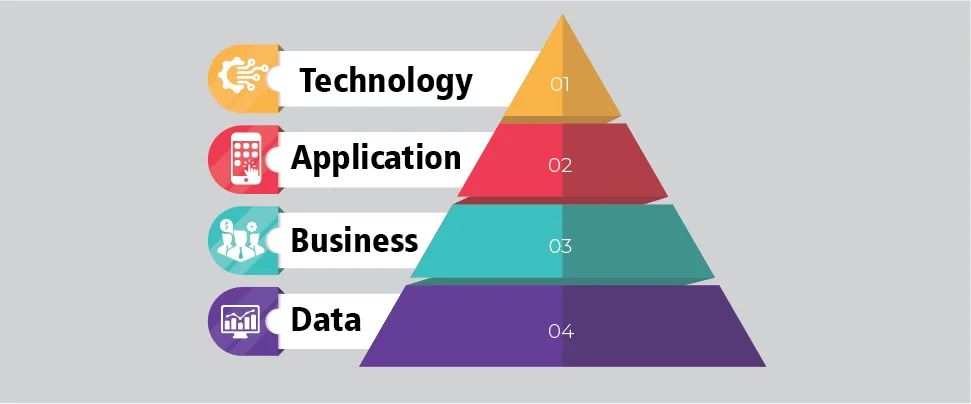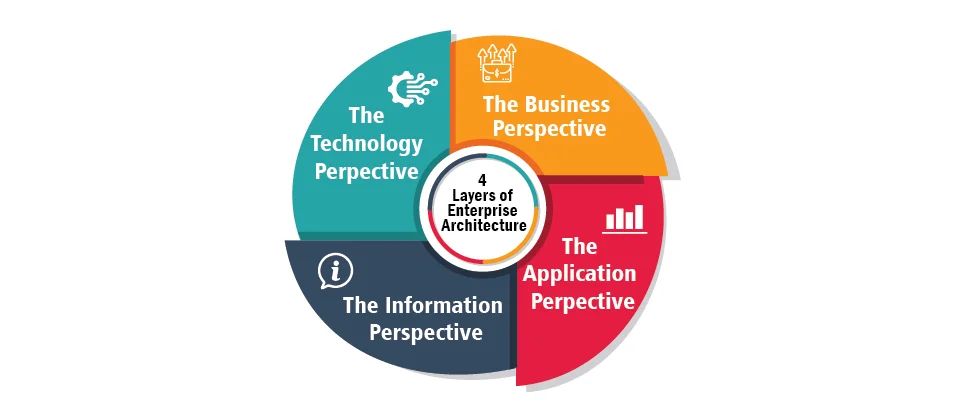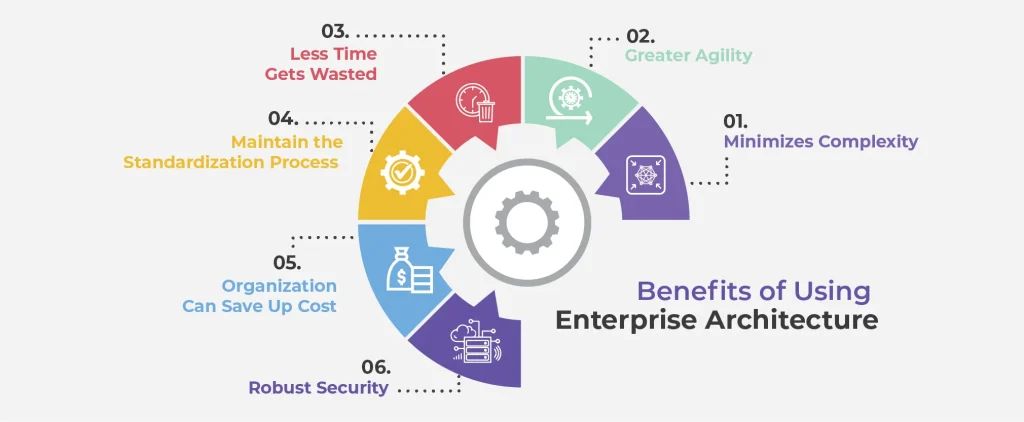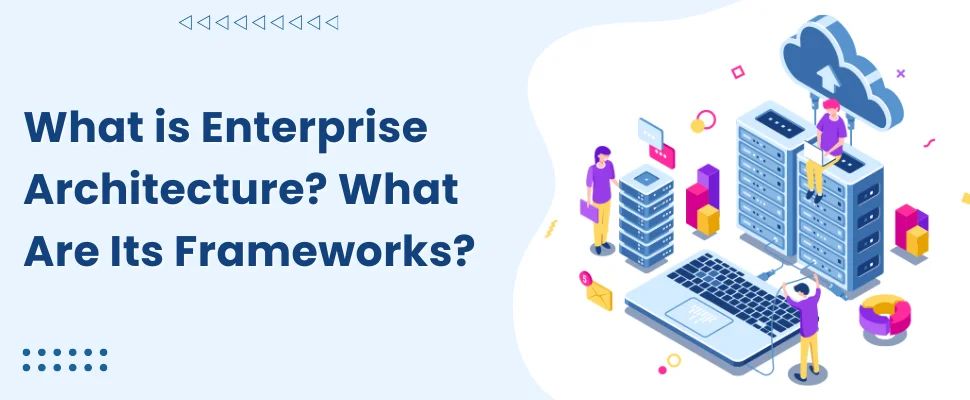Table of Contents
ToggleIntroduction
Since technology keeps changing and evolving at an unprecedented rate, businesses are also in a whirlwind. So, in this rapidly changing business environment, enterprise architecture helps businesses of all sorts achieve their goals with flexible strategies and guides them to reach their desired success. And most importantly, it helps to maintain the balance between IT performance and business development. In this article, we will see the four important frameworks for enterprise applications.

Don't miss out on your chance to work with the best
apply for top global job opportunities today!
What is Enterprise Architecture?

Enterprise architecture is a methodology that helps organize and manage the strategies within the organization and maintains the relationship between business strategies and IT systems. In simple words, it is like a blueprint or guide that helps organizations understand how to analyze business, plan, identify, design, and implement the structure so that they can reach the desired successful business outcomes. The idea of enterprise architecture started in the 1960s. However, the year 1980 marked a significant rise and widespread use of enterprise architecture frameworks. Since then, enterprise architecture has been characterized by combining applications with current and future processes to optimize business capabilities.
What are the Four Layers of Enterprise Architecture?

- Business: This defines the everyday organizational structure and relationships by using the organization’s business functions, goals, and overall strategies.
- Applications: The application layer defines business interactions and their core relationships. It also shows how businesses can implement their services.
- Information and Data: This architecture layer helps organizations improve other aspects of the infrastructure with positive feedback. This also ensures effective IT performance with optimal flexibility.
- Technology: This is the final architecture layer that provides all the necessary software and hardware in a structured way so that it meets the requirements of the organization.
What are the Frameworks of Enterprise Architecture?
Zachman Enterprise Framework (ZEF): Introduced in 1987 by John Zachman, this framework is one of the most popular and influential in this field. ZEF is a perfect planning tool for organizations to plan and organize complex enterprise systems. It provides six viewpoints to better understand how the organization works: planner, owner, designer, builder, subcontractor, and user. These six viewpoints help managers visually represent the information and how it interacts with each other in the business process. Rather than proving the methodology, it primarily focuses on six questions: what, how, where, who, when, and why. This technique ensures clarity about the roles within the organization and how the business works.
The Federal Enterprise Architecture Framework (FEAF): The main idea behind creating this is to share, organize, and collaborate with different federal agencies. This framework is built upon the National Institute of Standards and Technology; it promotes better planning and organizing processes and consistency. Similar to the Zachman enterprise framework, it also consists of six reference models: performance reference model (PRM), business reference model (BRM), data model (DRM), technical reference model (TRM), infrastructure reference model (IRM), and security reference model (SRM). Therefore, the primary goal is to improve interoperability within government by using one enterprise architecture for the whole federal government.
RM-ODP The Reference Model of Open Distributed Processing (ISO-RM-ODP): Three big organizations—the International Organization for Standardization (ISO), the International Electrotechnical Commission (IEC), and the Telecommunication Standardization Sector (ITUT)—collaborated to create an ISO-RM-ODP framework. It can handle processing even if the system is working on different platforms. It uses the object-modeling approach to represent the distributed systems. Moreover, it uses five viewpoints to solve the problem of the system. Those viewpoints are the enterprise viewpoint, the information viewpoint,tThe computational engineering viewpoint and the technology model.
The Open Group Architectural Framework (TOGAF): It is built upon the Department of Defense’s Technical Architecture Framework for Information Management. TOGAF, publicly released in 1995, is a free architectural framework. It does not offer many architectural principles but rather follows the best practices and a reusable set of existing architecture assets containing regulations. It has four views and viewpoints for the development of enterprise business architecture: data architecture, applications Data Architecture, and technology architecture. Views deal with the preoccupations. Out of these four viewpoints: Architecture Development Method (ADM), Enterprise Continuum, and Resource Base, ADM is considered the key component of this framework because it is considered best for making decisions with the organization, provides guidance for IT resources, and sustains architecture principles for growth and practical execution.
What are the Benefits of Using Enterprise Architecture?

Minimizes Complexity: Usually, complex systems generate many errors, which makes it hard for organizations to manage. Enterprise applications are the ultimate solution for maintaining the complexity of systems in organizations. By using the right tools, it effectively manages complex systems and detects and then terminates processes that do not contribute to targets.
Help to Maintain Standardization Process: Another benefit of using enterprise architecture is that it helps standardize processes and applications with more stability. Standard processes boost efficiency while minimizing the risks encountered at that time. In addition, it can also standardize IT processes and IT infrastructure successfully. This, in return, will provide more positive results for the organization.
Less Time Gets Wasted: Enterprise architecture significantly saves a lot of time for staff with the optimization of IT tools and processes. It can also help you get rid of bigger problems by solving them faster. As a result, staff can use their time on priority tasks and avoid disrupting the workforce.
Organization Can Save Up Cost: Enterprise architecture discards processes that do not serve any benefit to the organization. Not only that, but it also removes redundant and repetitive processes. Therefore, organizations can save significant resources and budgets by optimizing their IT infrastructure.
Greater Agility: Enterprise architecture offers a high degree of agility within organizations. Thus, organizations can organize, analyze, and implement the changes faster. Also, the strategies and IT processes can be quickly adapted to new models.
Robust Security: Enterprise applications are fully prepared with systematized security measures against cyber security breaches. With robust security against cyber security, organizations don’t need to worry about the data. It is important today to be prepared and strengthen the security system against cyber threats. Therefore, there won’t be any chances of a data breach from even the weakest point.
Final Words
Enterprise architecture is a robust tool for organizations that can help them grow and achieve success. By learning how to implement the right enterprise architecture in your organization, you’re unlocking the door to success. But having said that, it becomes extremely hard to select the right framework due to the many options available for enterprise architecture frameworks. With these top four frameworks, you can easily pick one enterprise architecture that aligns best with your business.
Take control of your career and land your dream job
sign up with us now and start applying for the best opportunities!

Frequently Asked Questions
The Zachman Framework (ZFA) is the most popular and best enterprise architecture unit today. It is well known for offering a comprehensive and structured way to organize. It is used across business, data, applications, and technology.
Enterprise architecture encompasses various architectural domains, including business, data, applications, and technology. It focuses on the holistic design and management of an organization’s structure, processes, and capabilities. Whereas business architecture focuses on the design and alignment of the enterprise’s business strategy, processes, and organizational structure.
The best practices include the following:
- Engaging stakeholders
- Leveraging frameworks
- Adapting to the iterative approach
- Continuous Learning
- Flexibility and standardization
- Good communication
- Implementing regular architectural governance
- Adapt to emerging trends
- Innovation and standardization
- Maintain architectural compliance.
For organizations, having an enterprise architecture is like a guide to success. It helps them to organize things efficiently, make lives easier, and to create a robust business
Enterprise architecture helps organize and manage the strategies within the organization and maintains the relationship between business strategies and IT systems. In this article, we will learn about enterprise architecture and its four important frameworks.

